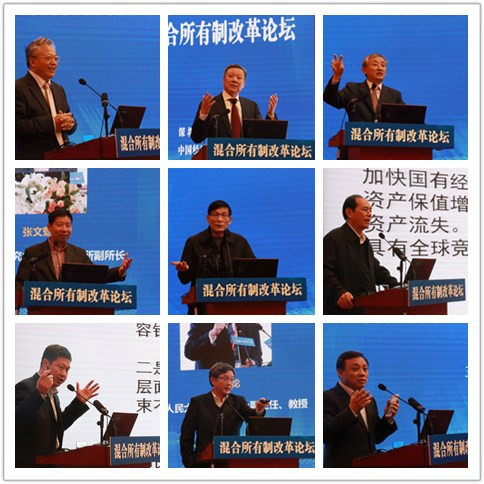Recap: Mixed-Ownership Reform Forum
The Mixed-Ownership Reform Forum was jointly hosted by Shenzhen Innovation and Development Institute (SZIDI) and China Society of Economic Reform (CSER) on December 2nd.
Moderator:
Mr. Siping ZHANG, former member of the standing committee of the CPC Shenzhen Municipal Committee
Panelists:
Mr. Qunhui HUANG, Chinese Academy of Social Sciences (CASS) Institute of Industrial Economics director
Mr. Xiaonan JI, Supervisory Board of Key Large State-Owned Enterprises former chairman
Mr. Zhenhua MAO, Shenzhen Innovation and Development Institute president
Mr. Huagang PENG, State-owned Assets Supervision and Administration Commission of the State Council vice Secretary-General
Mr. Xiaochu WANG, China Unicom president
Mr. Ruilong YANG, Renmin University school board vice director and professor
Mr. Wenkui ZHANG, China Development Research Center of the State Council Enterprise Research Institute vice director
Mr. Yunlai ZHU, China International Capital Corporation Limited (CICC) former president

Recap of the forum:
Mr. Xiaochu WANG points out that mixed-ownership reform should assign strategic investors with a say in decision-making. The “mix” part has finished in China Unicom, and now comes the “reform” part. He points out that now that the shareholding of SASAC in China Unicom has decreased from 62% to 36.7%, the next step is to:
• ensure the voices of private investors to be heard in decision-making
• streamline administration, which results in a decrease of 9 departments
• consolidate of party leadership, especially in areas of national security, information security, and important decisions to launch new projects, to appoint or dismiss key personnel, and to invest heavily
• establish asset management subsidiaries
According to Mr. Huagang PENG, mixed-ownership reform has moved forward rapidly:
• more than 2/3 centrally-owned enterprises have incorporated private capital, namely a total of approximately 300 billion RMB
• more than 1/2 state assets concentrate on listed companies
• 68.9% centrally-owned enterprises and subsidies have launched mixed-ownership reform , most of which concentrate in real estate, construction, building materials, communications and minerals industries
Nevertheless, PENG points out that challenges remain in mixed-ownership reform:
• resistance in some SOE, private companies and employees to implement
• corporate governance and marketization mechanism remain flawed
• party leadership struggles its way in business operation and management
PENG emphasizes that mixed-ownership reform should be furthered in those SOEs in competitive industries, and should create a win-win result for both SOEs and private players.
Mr. Wenkui ZHANG argues that mixed-ownership reform requires the introduction of ACTIVE non-state-owned shareholder. Their proportions should be the second or third largest, if not the largest, so that they can be on the board to make constructive contribution in decision-making and operations.
Mr. Yunlai ZHU reveals a series of data in which China’s economic output in 2016 reached to 74.4 trillion, total assets 725 trillion and liability 525 trillion. Its debt rate is 72%. If we consider China as a group company, its input-output ratio is rather low. If we consider the national GDP as the output of the country’s economic engine, of which the asset is more than 700 trillion, we would be surprised that its GDP is merely some 70 trillion. Therefore, we can’t evaluate SOE performance only using scale or growth rate but efficiency and returns.
Mr. Xiaonan JI pinpoints that mixed-ownership is the integration of public and private capital.
Mr. Qunhui Huang suggests that the goal of SOE reform should be systematical, with a focus on coordination.
Mr. Ruilong YANG contends that the current mixed-ownership reform lacks in real moves. SOE directors talk more than they do for fear that any unscrupulous moves would incur the accusation of “loss of state assets”; while private investors cannot get into certain industries or remain detached as they do not have a say.
Mr. Zhenhua MAO gives out another set of data, pointing to the resources that SOEs uptake. 85% of credit resources taking uo 95% of bond market and 90% of credit market are occupied by SOEs. Still, they are heavily in debt.


